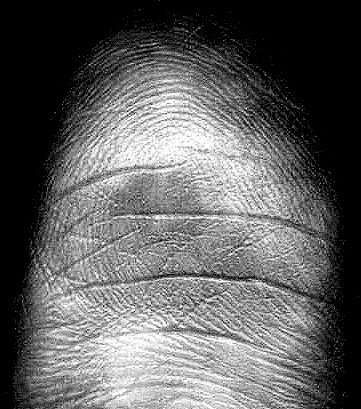Fingerprints
Today, I ask, "Who are you?" The University of Houston's College of Engineering presents this series about the machines that make our civilization run, and the people whose ingenuity created them.
There's been increased interest in fingerprinting lately. One article, by Melissa Stewart, goes to the underlying question: "How do you know I am who I say I am?" That's not the same question as, "Who dunnit?" Fingerprinting has always found greater use in certifying identity than it has in nailing crooks.
My 1930 birth certificate includes a print -- not of my finger, but of my then-tiny foot. Prints are still made at birth, but they're only for short-term in-hospital use. Mine was made fewer than twenty years after fingerprinting had become a mainstream forensic tool, and it still looked like jazzy hi-tech back then.
Four major identification methods have been used during the past century and a half: photography, Alphonse Bertillon's system of body measurement, fingerprints, and now DNA. Computer people have also been working on quick recognition methods -- retinal scans, for example. Each system has had to fight for acceptance, and none has been cleared of all ambiguity. Photography remains useful, though we understand its limitations. We can change our appearance intentionally, or it can change with illness or age.
Body measurement has come and gone. When my great grandfather came to America in 1843, long before Bertillon, immigration officials made a lengthy written list of his features. Bertillon's system of taking standard body measurements was cumbersome and complex, and our bodies undergo change with time.
People had already thought about fingerprints when the Bertillon system went into use. The grandson of astronomer William Herschel suggested that fingerprinting might help officials catch scoundrels trying to claim other people's pension checks.
J. Edgar Hoover made drama of fingerprinting to give the FBI its hi-tech look during the 1930s. Of course, without FAXs or copy machines, prints were very hard to use. We had to rely on a system invented in 1895 by Edward Henry for describing fingerprints with descriptive symbols. It was 1967 before we could read and compare prints optically.
All the while, the main use of fingerprinting has been to create identities -- of runaways, of unidentified dead, of people already arrested. That's also true for DNA today. DNA does far more to certify our identity, and that of our forebears, than it does to catch criminals -- even though the forensic arena is where these methods have always made the best theater.
But, ever since Martin Guerre -- ever since Oedipus -- identity has posed the more pressing questions. Am I who I claim to be? My wife likes to tell me that she wonders if I've been replaced. I take that as a good sign, since to stay the same can be a kind of death. Fingerprints or DNA notwithstanding, we had better change. Still, I'll give her no chance to dust my footprints. Wouldn't it be terrible to find that the patterns failed to match, after all?
I'm John Lienhard, at the University of Houston, where we're interested in the way inventive minds work.
(Theme music)
Stewart, M., Fingerprints. Invention & Technology, Summer 2001, pp.22-30.
As a matter of interest, the 1897 Encyclopaedia Britannica says nothing at all about fingerprints. The 11th edition (1910-11) traces the practice back to the ancient placement of a thumb print on a document, and mentions the recent interest of law enforcement in fingerprinting.
